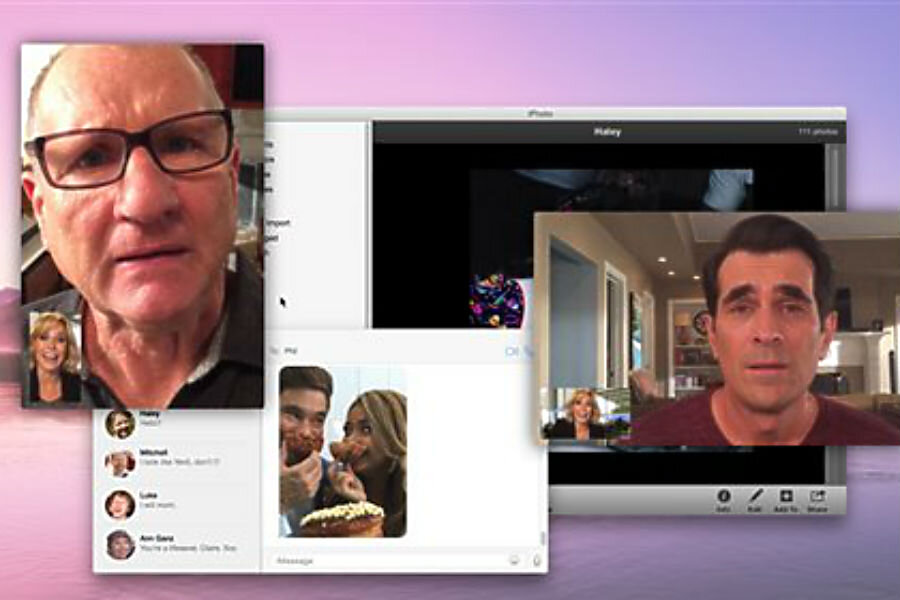Why this 'Modern Family' episode was shot with an iPhone
Loading...
| New York
For this week's "Modern Family," producers put down their expensive professional cameras and shot the episode with iPhones and other Apple devices. Seen through the eyes of character Claire Dunphy as she uses a Mac laptop, characters only appear on her computer's FaceTime video-calling app.
The Associated Press spoke with series co-creator and executive producer Steve Levitan about the thinking behind shooting with a smartphone and lessons learned. The episode, "Connection Lost," airs on ABC at 9 p.m. EST Wednesday and is available online Thursday (Hulu Plus, cable or satellite subscription required until next week).
Questions and answers have been edited for clarity and length.
___
Q. What did you find most surprising?
A. We thought the actors would be their own camera person originally, but it's just a lot for them to have to get everything framed just right. We quickly devised a method where a camera person held the phone just in front of them. So that it didn't look like the phone was floating in space, we always had an actor put their hand on the cameraman's hand. That made it look like they were doing a selfie thing.
Q. How does the iPhone compare with traditional cameras?
A. When you have a controlled environment, it's easy to get nice-looking images. The challenge comes when you're dealing with extremes — extreme brightness and darkness. The cameras we typically use cost tens of thousands of dollars and use lenses that cost just as much. You're going to always get a better quality with those. But the phone's quality is quite good. It's just amazing what's happened to smartphones in five years.
Q. Could you have achieved the same effect with professional cameras?
A. We wanted it to look as real as possible, so rather than shoot it on this incredible camera and then dumb the image down a bit so it looks like an iPhone, why not just shoot it with an iPhone? This is certainly good enough for our purposes, and it made the most sense.
Q. Where do you see this going, not just with iPhones but other consumer gadgets such as GoPro video cameras and digital SLRs?
A. It opens up filmmaking to people who don't have the resources for expensive equipment. There's a movie at the Sundance film festival this year that was shot on an iPhone. You really can, if you wanted to, shoot a movie on an iPhone or a thousand-dollar camera and then edit it on your computer. If you're clever enough, it can look like an expensive movie. That said, filmmaking is not just about having the technology and the camera. It's also about having a vision and the story. That's always going to rely on good old-fashioned human ingenuity.
Q. How do you avoid making the equipment the center of the attention?
A. The really compelling part here is the story telling, not so much how we did it technologically. At the end of the day, this story needed to be told this way. It's an emotional story, and it's a funny story. Ultimately when you have that going for you, it keeps this from becoming a gimmick. While the iPhone thing is a nice headline, I hope ultimately people remember this as a compelling episode.
Q. There are lots of Android and Windows users out there. Do you worry about criticism that you are focusing too much on Apple?
A. This is the way my family communicates. We happen to be an Apple family. This is the technology that I know. If Claire started contacting everybody through Google Hangouts, it would have felt less believable to me because I don't know anybody who uses it that way. It doesn't mean people don't, but I don't. Samsung makes beautiful TVs. They make beautiful phones. It just so happens that I use Apple, so it's the way that makes sense for me. (After producers reached out to Apple, the company provided devices, but didn't pay for their inclusion.)
Q. Any tips for budding filmmakers?
A. Using this kind of technology is nothing but a means to an end. The more important thing is to spend time on the story and the characters and make sure you have something compelling that's worth actually using these devices for. If you don't, it's very easy to come up with beautiful images and fun camera tricks. The real difficult part is to have something worth filming. That's where you should put the bulk of your time and energy.
Copyright 2015 The Associated Press. All rights reserved. This material may not be published, broadcast, rewritten or redistributed.







